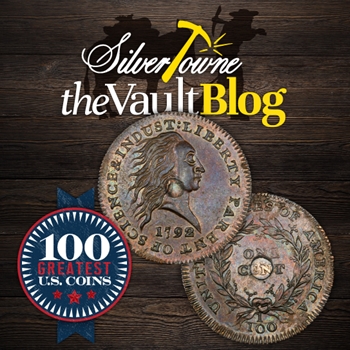
1792: a big year in numismatics. The first thing to come to mind? The Coinage Act of April 2, 1792. After the United States Constitution was ratified by a majority of the states in 1788, Congress members and many of its founders found the need for a national Mint to create an identity among a brand new economy. Cut to 1792 and the first mint would be established and Philadelphia would be chosen as its location for, at the time, the Pennsylvania town was the nation’s capital.
While the first circulating coins would not be produced until 1793, coinage in the form of copper would immediately be produced. Among these, the half cent and the cent coins. But if you are knowledgeable about the way the United States Mint operates, you are aware of pattern pieces and their intent behind them. From the very beginning of the United States Mint and its production, the next edition of our blog series focusing on Whitman Publishing’s top 100 Greatest U.S. Coins features a pattern coin and the first representation of a bimetallic coin from the government of the United States. Authors Scott Schechter and Jeff Garrett along with influential figures throughout the numismatic hobby take us into the world of this very rare 1792-dated coin that lands on the list according to the publication’s fourth edition.
#40 - 1792 Silver-Center Cent
Today’s production of cent denomination coins is very different from the approach taken in 1792. The public’s attitude towards coins and them not containing the full value in metal was cause for immediate dismissal when it came to merchants and vendors accepting them upon exchange. This view was more so towards coins that contain gold and silver, but it also included copper coins. Copper, however, led to a very heavy and very large coin when produced at full value. This caused the Mint to reevaluate how they produced the cent coins.
In an attempt to lessen the size of the coin, they examined adding a small amount of silver to replace a large portion of the copper. In a version contemplated, they mixed and melted both the copper and silver metals together which ultimately led to the decision that it was unreasonable to be able to tell by appearance whether or not the coins contained silver. Albeit, counterfeiters would have a field day making coins out of copper only and leaving silver out of the equation altogether in order to make more money.
At the time, Henry Voight was the Chief Coiner at the United States Mint. He proposed placing a small plug of silver in the middle of the copper cent coin to bring the value up to equal that of one cent to solve the overall problem. To do this, they drilled a small hole in the center of the blank and inserted a silver plug. The coin was then struck, simultaneously flattening the silver plug out and filling the hole in the middle. The concept and solution overall were praised but the process itself was said to be “inefficient and unsuitable for mass production”. From then on, the United States Mint decided to make the cent coins from 100% copper.
The overall rarity of the 1792 Silver-Center Cent is extreme. The certified population is that of only 15 as of the fourth edition of the Whitman publication. In 1960, this coin in a Very Fine condition was valued at $1,500. The most current value from, once again, the fourth edition of the 100 Greatest U.S. Coin series is $300,000.







